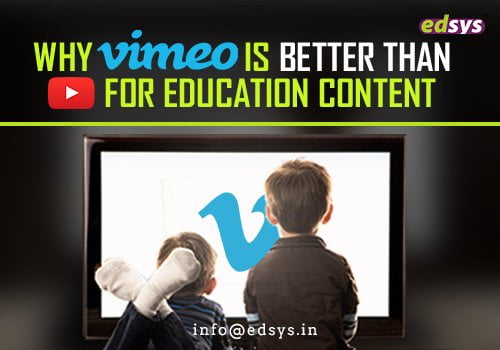
Vimeo and YouTube are undoubtedly among the most popular video sharing platforms. But, are these created equally well for all purposes? The answer is no. Both platforms come with their own strengths and weaknesses. When you want to create education content, Vimeo is a much better platform compared to YouTube.
Let’s try to understand why.
1) Privacy & Security

For a course content creator, controlling the privacy levels of the courses created is of utmost importance. In case of YouTube, there are three different privacy options – private, unlisted and public.
Private is too restrictive as you will struggle to share the content. Because of this, Unlisted is mostly used to prevent YouTube Audience from accessing the content from the channel or search. But when unlisted, anyone can just copy the URL and share it however they want, and view the content or even download and save.

On the other hand, Vimeo offers five different options that you can see in the screenshot below. These options allow you to show the video exclusively to the intended audience.
When you restrict access, users won’t be able to copy the video URL. Even if they copy the url from the html, all they will get is a page error. Under paid Vimeo plans, users can restrict embedding of videos to own website as well. So there are a number of privacy or content security features that makes Vimeo a much better choice for Course content creators.

2) Control

Vimeo offers plenty of control. There are options to password protect videos, limit the viewers, restrict video embeds, set next course video as end cards, domain-level privacy, private link sharing, private team projects, etc.
On the other hand, YouTube offers limited control. You can decide to allow or not allow video embed. When embedded, user can hide the on screen controls. That’s pretty much it.
3) Updating Video

It is natural for content creators to make changes to an uploaded video occasionally due to production mistakes or to add additional content. Apart from minor edits using YouTube’s own editing features, user cannot update video on the same URL. An updated version will have a new URL which would have to be changed wherever you have embedded and shared.

But in Vimeo’s case, you can easily replace an existing video with an updated version without changing the URL. So, no need to worry about broken links and updating the URL in umpteen places.
4) User Experience

There are two key aspects that mar the user experience on YouTube – Ads and related/recommended videos. This can be especially detrimental for creators producing Course Content. It can divert user attention away from your content and makes it harder to retain your audience. But this is expected since YouTube is a free platform.
On the other hand, Vimeo offers a much better user experience. It is ad-free, and you are able to choose the specific videos you want your audience to see.
Also Read : What is Distance Learning: What are it’s Benefits?
5) Branding

Vimeo’s video player has one significant advantage in its ability to customize branding. You can change the color of the player effortlessly and add your logo. This will reflect across your previous videos as well, without requiring any coding changes. It would look great especially if you are embedding on your website.
YouTube simply doesn’t offer a similar feature on their video player, and ends with irrelevant video suggestions.
6) Advertisements
You would be familiar with different types of YouTube Ads – these take away user attention and divert users from your content. Also, these are a direct result of the platform being free to access for public. As a result, the perceived quality of content is also relatively lower
Vimeo do not have ads, and it doesn’t look like their policy will change any time soon. So, your content would appear of higher value on Vimeo and this helps in retaining your students or users.
7) Video Quality

YouTube caters to a huge number of creators and audience. This causes a higher processing load, and to manage them, YouTube has to use higher compression. Vimeo on the other hand has lighter processing load, uses a higher bitrate and supports higher audio quality.
The result is that, when the same quality video is uploaded on Vimeo and YouTube, it looks better on Vimeo. It could be said that this difference is due to Vimeo’s focus on quality and YouTube’s focus on quantity.
8) Tools

If you don’t have expansive production budget and want to create videos quickly, Vimeo features the Vimeo Create. It comes with easy to use features such as custom templates. Vimeo had acquired video creating app Magisto and it has been integrated with the platform.

YouTube on the other hand, has decent editing features but lacks features that enable easy video creation.
9) Support

YouTube is primarily a free video sharing platform, and it offers a lot of free documentation that can help you from a vast support community. But if you are looking for specialized, in person help, then a paid Vimeo plan is the better option. Vimeo offers different levels of support such as email and live support.
The community support in Vimeo is more supportive with constructive feedback despite the community being smaller in size.
Also Read : 15 Virtual Classroom Technology and Apps
10) API Integrations

Vimeo provides a wide array of integration compared to YouTube. It integrates with Dropbox, Adobe, MailChimp, Google Analytics, Constant Contact, and a lot more. Developers can use the API to integrate all the awesome features of Vimeo.
The YouTube Data API on the other hand allows adding YouTube functionality to your website, search functionality, playlist management and video analytics.
[“source=edsys”]





